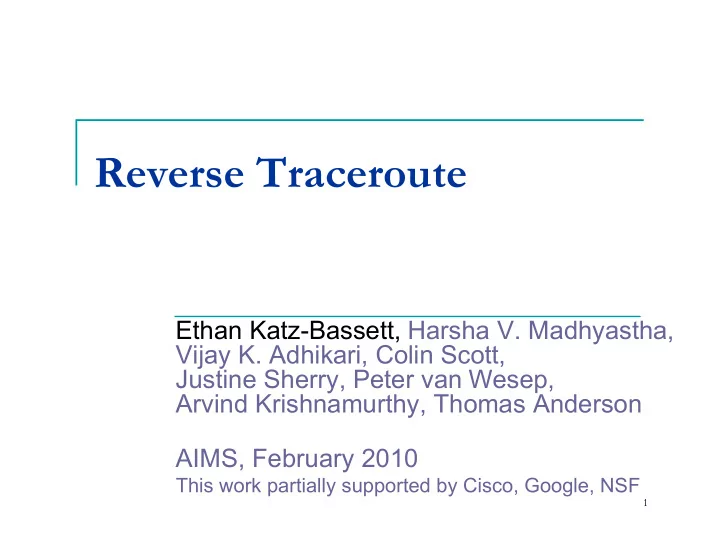

Reverse Traceroute Ethan Katz-Bassett, Harsha V. Madhyastha, Vijay K. Adhikari, Colin Scott, Justine Sherry, Peter van Wesep, Arvind Krishnamurthy, Thomas Anderson AIMS, February 2010 This work partially supported by Cisco, Google, NSF 1
Motivation: Google Wants Reverse Paths “ The number one go-to tool is traceroute. Asymmetric paths are the number one plague. The reverse path itself is completely invisible .” Richard Steenbergen, CTO, nLayer Communications NANOG Network operators troubleshooting tutorial, 2009 “ To more precisely troubleshoot problems, [Google] needs the ability to gather information about the reverse path back from clients to Google .” Google IMC paper, 2009 Goal: Reverse traceroute , without control of destination 2
Want reverse path from D back to S , but don’t control D Set of vantage points around the world 3
Traceroute from all vantage points to S Gives atlas of paths to S ; if we hit one, we know rest of path 4
Build back hop-by-hop to atlas (assumes destination-based routing) Set of techniques to measure hops using IP options 5
Build back hop-by-hop to atlas (assumes destination-based routing) Set of techniques to measure hops using IP options 6
Build back hop-by-hop to atlas (assumes destination-based routing) Set of techniques to measure hops using IP options 7
Once we see a router on a known path, we know remainder 8
Techniques combine to give us complete path 9
Status of Project and This Talk Appearing in NSDI 2010 http://revtr.cs.washington.edu PlanetLab and MeasurementLab nodes Measure paths from arbitrary IPs to PL nodes Revising system to improve scalability, overhead Plan to use Scamper (thanks Matthew!) Then open system to let users measure to themselves This talk: applications to link latency and topology mapping NSDI paper: technique, accuracy, coverage
Motivation: Apps Want Link Latencies Traceroute/ping give round-trip time (RTT) … but many apps want one-way link latency Peter’s and Noa’s geolocation talks yesterday Path performance estimation (iPlane) ISP comparison (Netdiff) Troubleshooting poor performance
Measuring Link Latency Traditional approach: Delay(A,B) = ( RTT(S,B) – RTT(S,A) ) / 2 Asymmetry skews link latency inferred from traceroutes
Reverse Traceroute Detects Symmetry Reverse traceroute identifies symmetric traversal Identify cases when RTT difference is accurate Many links traversed symmetrically from some vantage points, not others
Reverse TR Constrains Link Latencies RTT(A,B)=Delay(S,A) + Delay(A,B) + Delay(B,C) + Delay(C,S) Build up system of constraints on link latencies of all intermediate hops Traceroute and reverse traceroute to all hops RTT = Forward links + Reverse links Open issues: Treat unbound links as segment? MPLS?
Measuring Sprint’s Link Latencies We see 79 of Sprint’s 89 inter-PoP links, whereas traceroute only sees 61 Median (0.4ms), mean (0.6ms), worst case (2.2ms) error all 10 x better than with traditional approach
Motivation: Ricardo Wants Peering Links “New inference techniques are needed to capture or estimate peer links” Ricardo Oliveira, SIGMETRICS ‘08 Only AS and its customers see/use its peer links No path will traverse > 1 Trad. methods miss links V1 and V2 can’t traceroute AS3-AS2, AS3-AS5 Most peer links invisible to RouteViews, RIS Reverse traceroute sees AS3-AS2 and AS3-AS5 AS3 peers w/ other ASes shown
How many extra links do we see? Considered just peering links at IXPs Baseline: 58,534 IXP links on 51,832 AS pairs IXPs: Mapped? [B. Augustin, B. Krishnamurthy, and W. Willinger. IMC ‘09] Most exhaustive study of IXPs yet Traceroutes from 1000s of hosts, source routing Reverse traceroute enriches the study: 9096 additional IXP links (16%) 5057 additional distinct AS pairs (10%) 1910 of those also not in iPlane or UCLA data
Reverse Traceroute Vs Ono Complementary approaches to measuring more routes Reverse traceroute Ono Use existing VPs to Use P2P (need / have measure any destination peers everywhere) Relies on IP options, Relies on standard spoofing traceroute (Future) On-demand On-demand? Arbitrary measurements for all targets? For all? Paths from arbitrary Paths reflect actual locations (used in apps) end-user traffic, edge Scalable? (I built it) Scalable (Dave built it)
Conclusion and Questions for You Traceroute is very useful, but can’t provide reverse path Our reverse traceroute system addresses limitation, providing complementary information Gives most hops as if you issued traceroute from remote site Useful in wide range of situations, including: Accurately measuring link latencies Exposing “hidden” topology What should we measure? Ideas on more vantage points? 19
Recommend
More recommend